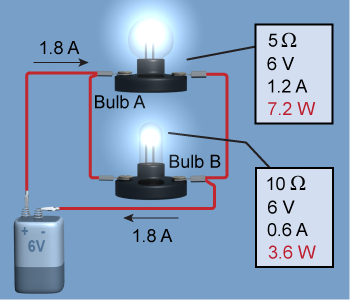|
A key circuit-design goal is to make electrical power appear where you want, in the form you need, and at the rate you desire. You may want three lamps lighting your bedroom as brightly as possible, or two electrical heaters warming your basement without starting a fire. Should you connect them in series or parallel? To answer this, we need to understand power in series and parallel circuits. 
|
 In a series circuit, which element draws the most power? In the example at right, resistor B has twice the resistance of resistor A and both are connected to a 6 V battery. For each resistor, the power is P = IV. The voltage drop across each element may vary, so we eliminate V by using Ohm’s law. Substituting IR for V in the power equation results in P = I 2R. Since the current across each resistor is the same in a series circuit, the power is therefore proportional to the resistance—so the highest resistance element consumes the most power, 1.6 W versus 0.8 W! To understand this property, think of a stream of traffic approaching a narrow bridge. The traffic loses the most energy where it has to fight hardest to get through!
In a series circuit, which element draws the most power? In the example at right, resistor B has twice the resistance of resistor A and both are connected to a 6 V battery. For each resistor, the power is P = IV. The voltage drop across each element may vary, so we eliminate V by using Ohm’s law. Substituting IR for V in the power equation results in P = I 2R. Since the current across each resistor is the same in a series circuit, the power is therefore proportional to the resistance—so the highest resistance element consumes the most power, 1.6 W versus 0.8 W! To understand this property, think of a stream of traffic approaching a narrow bridge. The traffic loses the most energy where it has to fight hardest to get through! 
|
 Things change dramatically if we wire the resistors in parallel. Now each is exposed to the full voltage provided by the battery. This means that the voltage drop V is the same for each resistor, while current I may differ from one to the next. We eliminate I from P = IV by inserting I = V/R. This yields P = V 2/R. In a parallel circuit, the power consumed by a resistor is inversely proportional to the resistance, so the smaller resistance (resistor A) operates at twice the power of the other! Furthermore, even resistor B has a greater power output than it did in series! Now the power dissipated by the 5 Ω resistor increases to 7.2 W and the power dissipated by the 10 Ω resistor is 3.6 W, for a total of 10.8 W (compared to only 2.4 W for the series circuit).
Things change dramatically if we wire the resistors in parallel. Now each is exposed to the full voltage provided by the battery. This means that the voltage drop V is the same for each resistor, while current I may differ from one to the next. We eliminate I from P = IV by inserting I = V/R. This yields P = V 2/R. In a parallel circuit, the power consumed by a resistor is inversely proportional to the resistance, so the smaller resistance (resistor A) operates at twice the power of the other! Furthermore, even resistor B has a greater power output than it did in series! Now the power dissipated by the 5 Ω resistor increases to 7.2 W and the power dissipated by the 10 Ω resistor is 3.6 W, for a total of 10.8 W (compared to only 2.4 W for the series circuit). 
|
The same resistors will always produce more power when connected in parallel than when connected in series. The effect is similar to that of opening another bridge across a river that many drivers are eager to cross—many more vehicles can cross the river each minute. 
|
Series circuits have several advantages. For example, putting a fuse or circuit breaker in series with an electrical heater ensures that the heater will be cut off if it draws an unsafe amount of current. In contrast, the heater and your computer should be in parallel, so that if one is turned off the other can stay on. 
|
| |
|

